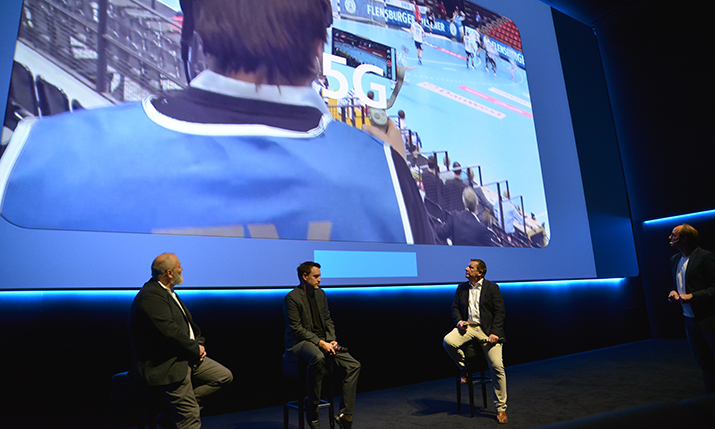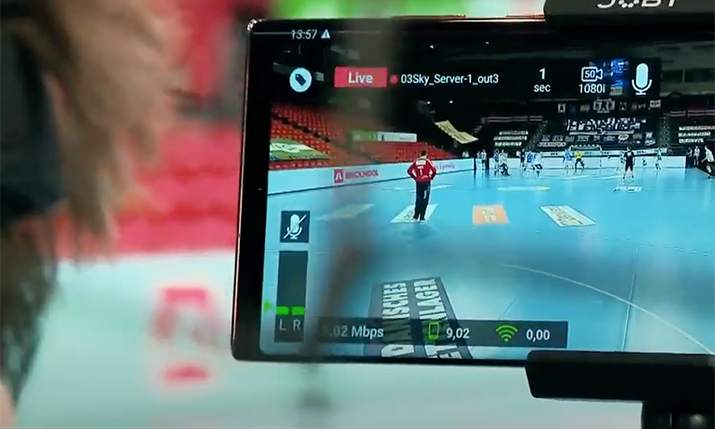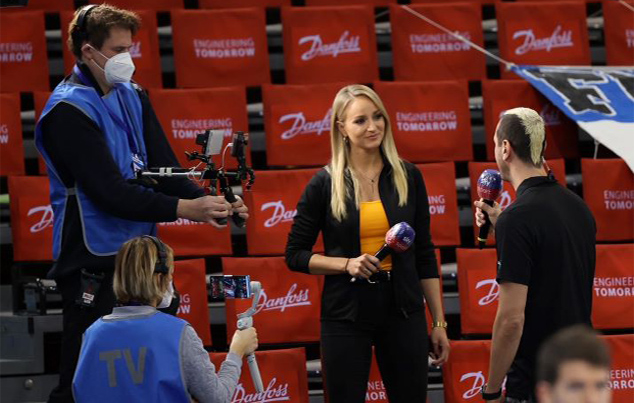Evolution not revolution: Sky Sport and Telefonica discuss the use of 5G in sports broadcasting and production

There’s currently a lot of buzz surrounding 5G in the public domain. In Germany, for example, over 100 cities are already fully 5G equipped, transforming the potential of day to day activities with promises of lightning-quick connectivity and unlimited bandwidth.
With O2/Telefonica promising full 5G coverage in Germany before 2025, the sports broadcasting industry has already started to realise that it also has the potential to significantly change how we create – and consume – content.
The “Sky and Telefonica 5G Handball Journey” panel at the Sky Sport Summit 2021, in cooperation with SVG Europe, was perhaps, for this reason, one of the most anticipated and hotly contested sessions of the event, which took place at the Dolby Cinema in Central Munich on 27 September.
“We wanted to give the viewer a feeling of proximity to the match. From action on the actual handball pitch to cheering crowds, the smartphones succeeded in providing us with a totally refreshing narrative, a direct result of the flexibility of 5G.”
Alessandro Reitano, senior vice president of sports production at Sky Germany, chaired the panel, which saw Daniel Url, head of global product management at Vizrt, Markus von Böhlen, director of trading, devices and digital life at O2/Telefonica and Peter Frantz, CEO of Netorium/ LiveU, deconstructed the recent 5G Handball broadcast, which was the first of its kind in Europe.
The lower-tiered sports event – which was 100% cloud produced – was broadcast using 12 Samsung Galaxy smartphones to transmit 134Gb of content to Sky’s production studios in Unterföhrung.
Astonishingly, the 5G network (including Nokia Airscale technology) at the Flens Arena in Flensburg, Germany, was constructed in just seven days. This experiment of sorts was dissected by the panel, who made some interesting conclusions about what this could mean for broadcasting in the future.
5G as a catalyst for creative production methods
The panel agreed that the use of smartphones as camera devices for the Handball event highlighted the possibilities of harnessing new dramaturgical perspectives. Whereas static cameras require lots of space and distance to the pitch area in order to achieve the correct angle, the agility of the smartphone coverage produced new and previously unseen angles, with the added benefit of being able to quickly pan to follow the fast-moving action.
“The smartphones gave us a blank slate of sorts upon which to compose a new broadcasting narrative,” commented von Böhlen. “We wanted to give the viewer a feeling of proximity to the match. From action on the actual handball pitch to cheering crowds, the smartphones succeeded in providing us with a totally refreshing narrative, a direct result of the flexibility of 5G.”
However, not all panel members were convinced of the quality of such new dramaturgical perspectives offered up by 5G.
“While it is true that the agility of smartphones as capturing devices enabled us to create quick pans and unexpected, flexible follows; it’s precisely these fast movements which ultimately proved sometimes somewhat borderline in terms of quality,” commented Frantz.
“As a result, the limited computing capacity and camera quality of the smartphones meant that we did see patches of, what I would consider being semi-professional broadcasting quality.”

5G: expanding the definition of viewing consumption?
Thanks to 5G’s ability to bond different bandwidths and channels together, data and content can be utilised within the same transmissible ecosystem, bringing huge advantages for content creators looking to deliver extra information to devices.
As a result, there is potentially more scope to offer viewers more real-time data, camera angles, match statistics and other viewing-enriching services. Whereas currently such add ons are available to some high profile tier 1 sports events, there is a definite democratising factor associated with 5G in the sense that such added benefits will also be available when streaming lower-tier sports events.
“We have to think about what kind of added value 5G can offer a production,” continued Reitano. “With the ability to distribute more content, we can assume that the viewer has access to better quality footage with greater engagement. If the handball event has taught us anything, it is that 5G is going to totally transform the viewing experience of lower-tiered sports events.”
Potential 5G pitfalls
While 5G will inevitably lead to positive changes on the creative side, the panel were, however, unanimous in their concerns about the deployment of 5G. Echoed sentiments included the necessity of guaranteeing a strong and consistent connection: crucial if 5G is to prove a viable alternative for broadcasting in high profile tier 1 sports events.
With consumer data usage already at record levels, von Böhlen commented that the imminent introduction of 5G will inevitably accelerate use of data, which in itself could pose problematic for burgeoning 5G production plans.
“At the moment we’re limited with 5G because of the cost of the infrastructure required to operate it,” he commented. “Providing enough network capacity to support even a basic service is going to be the biggest challenge for organisers and venues.”
“As this event demonstrated, 5G is enabling the possibility of turning up to a tier 4 event with a laptop and a smartphone and broadcasting the event entirely using cloud services.”
In addition to infrastructure, the issue of signal security was also voiced, especially with regards to the single point of failure present when only one connection is available. Bonding (a process where several channels are lumped together for more security) is both inherent to 5G and necessary to guarantee the stability of transmission, and negates a significant proportion of the concern regarding connectivity.
For in-stadia 5G projects to succeed, however, there needs to be seamless collaboration between key players such as venue owners, mobile network operators, rights holders and content providers. While this may be a case of easier said than done, the common goal of 5G content production could be just the motivating factor necessary to catalyse such cohesion.

New perspectives
From the effective operation of camera smartphones to technical content production, the handball event also highlighted the fact that broadcasting players are navigating uncertain waters, especially with regards to technical know-how. While it’s true, as Reitano commented, that Broadcast doesn’t allow for mistakes, teething problems are to be expected with future 5G events, and should be embraced as part of the learning curve.
What’s more, with the potential onslaught of visual data received through 5G, problems will inevitably arise on the production side as to how to best process the mass of data. Instead of having to employ a further 10 people on the production side, scalable software solutions are required to harness and process all the incoming data streams. Otherwise, the panel agreed that there will be significant cost factors associated with 5G.
“The freedom and flexibility of 5G is unprecedented,” commented Url in his closing remarks. “As this event demonstrated, 5G is enabling the possibility of turning up to a tier 4 event with a laptop and a smartphone and broadcasting the event entirely using cloud services.
“Five years ago, nobody would have said that production would have moved 100% to the cloud. I think we’re also at a similar place right now with 5G. In five years, with a full country-wide 5G rollout, it’s quite probable that 5G will be second nature to sports broadcasters, who will have almost certainly seamlessly integrated many of the measures discussed today into our day to day work processes.“
Sky Sport Summit 2021, in cooperation with SVG Europe, took place in Munich on Monday 27 September.
